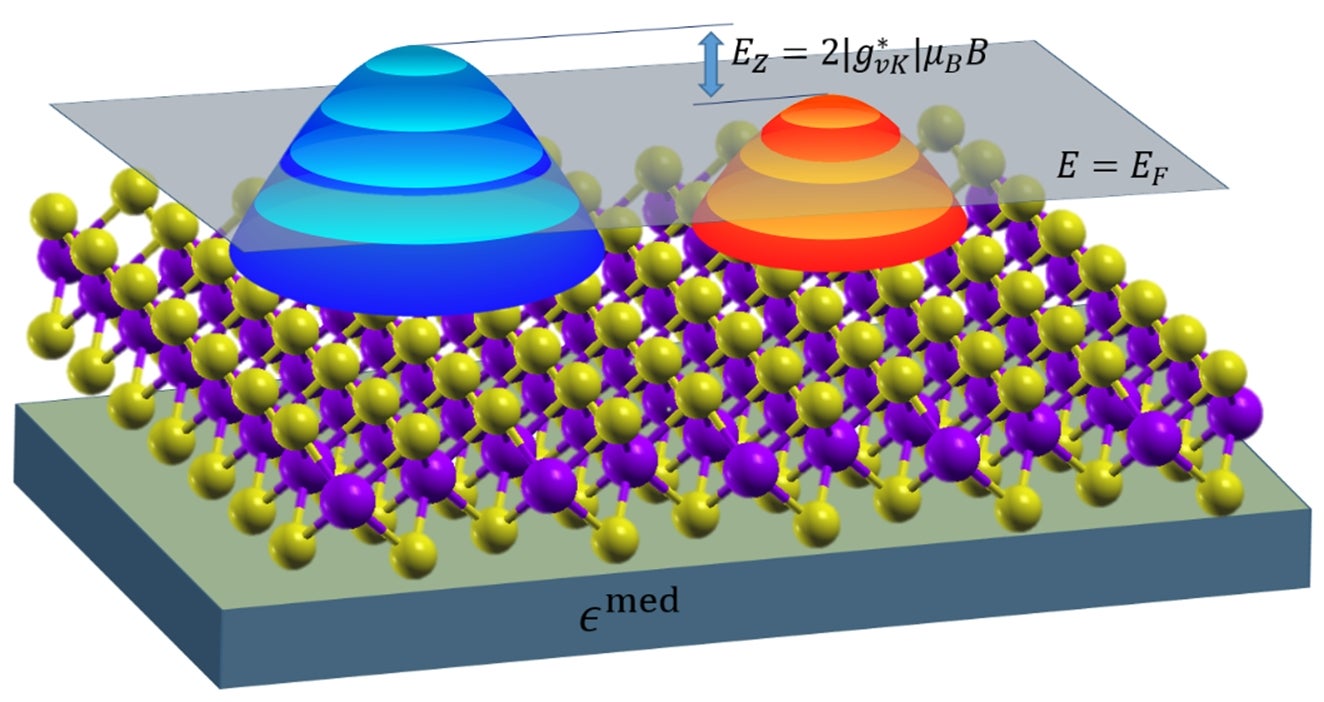Alignment of quantized levels in valleytronic materials
June 13, 2022NUS researchers have predicted that Landau levels belonging to different valleys in a two-dimensional (2D) valleytronic material, monolayer tungsten diselenide (WSe2), can be aligned at a critical magnetic field.
The alignment of distinct entities, such as two laser beams, or two pillars, is a common goal in many fields of science and engineering. In the more exotic world of quantum mechanics, the alignment of quantized electronic levels can enable the creation of particles called pseudo-spinors that are useful for quantum computing applications.
Quantized electronic levels emerge when a magnetic field is applied to a 2D material. These levels are called Landau levels. Of particular interest are Landau levels in valleytronic materials. Valleytronic materials are materials in which one can control not just the charge or spin of an electron, but also the “valley” to which the electron belongs. In general, charge carriers in different valleys travel in opposite directions.
In this work, the research team led by Associate Professor QUEK Su Ying from the Department of Physics, National University of Singapore developed an approach to account for the effect of dynamical electron-electron interactions when predicting the energy levels in valleytronic materials in the presence of a magnetic field. Their predictions showed that these many-body interactions amplified the effects of a magnetic field on the materials by causing a shift in their energy levels. When applied to monolayer WSe2, the computational results were found to be in quantitative agreement with experimental literature, validating the new approach. This amplification is quantified by an enhancement of the so-called Landé g-factors (see Figure).
The team observed that the enhancement in the g-factors arose due to a change in the population of charge carriers in each valley, in response to a change in the magnetic field. However, when the magnetic field is sufficiently strong such that all the carriers are located in the same valley (all carriers move to the blue valley in the Figure), this change in carrier population can no longer happen, and the g-factors drop abruptly. At this critical magnetic field, the charge carriers can oscillate back and forth between the two valleys and this can lead to the alignment of Landau levels in the two valleys.
Dr XUAN Fengyuan, a postdoctoral fellow on the research team said, “Due to the large g-factors present in WSe2, the critical magnetic fields predicted are small so this effect can be realised in standard laboratories.”
“Compared to previous proposals, the alignment of Landau levels predicted in this work is robust to fluctuations in the carrier density. Recent observations of fractional quantum Hall states in 2D WSe2 suggest the possibility of using Landau level alignment as a means to enable topological quantum computing applications,” added Prof Quek.

Landau levels in doped monolayer tungsten diselenide (WSe2): Schematic showing the Landau levels in doped monolayer WSe2, in response to an external magnetic field, B. The valleys are shown in blue and orange. The g-factor, g*vK, is enhanced due to dynamical many-body interactions arising from the change in carrier density in each valley, as the energy difference between the valley extrema, Ez, changes with B.
Reference
Xuan F; Quek SY*, “Valley-filling instability and critical magnetic field for interaction-enhanced Zeeman response in doped WSe2 monolayers” NPJ COMPUTATIONAL MATERIALS Volume: 7 Article Number: 198 DOI: 10.1038/s41524-021-00665-8 Published: 2021.


